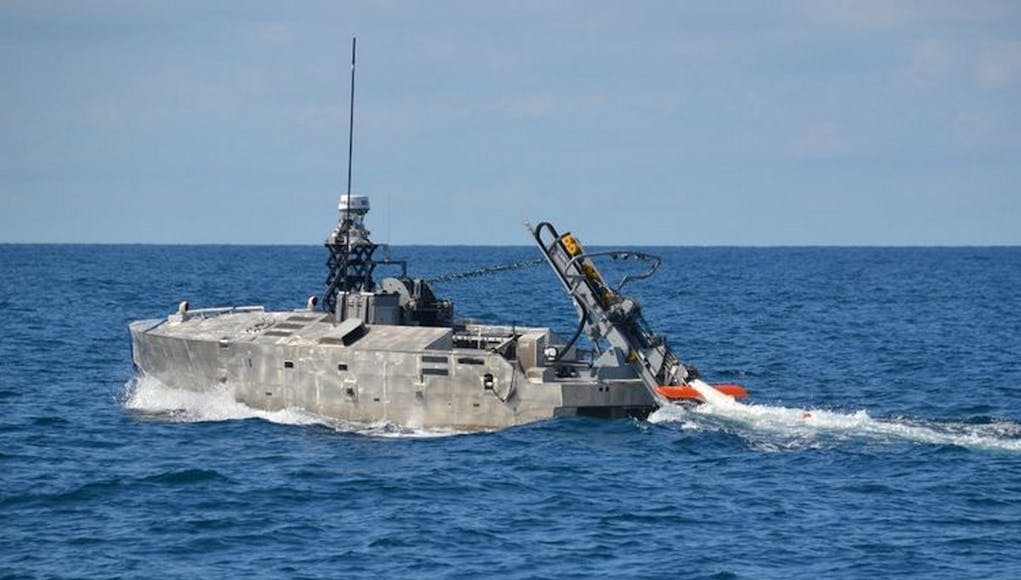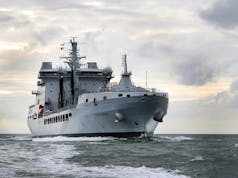Northrop Grumman’s AQS-24 mine hunting sonar recently completed initial in-water testing of a next-generation Deploy and Retrieval (D&R) payload.
Operated from the Mine Countermeasures Unmanned Surface Vessel (MCM USV), the firm say that the AQS-24 D&R demonstrated the unmanned operations needed to perform a mine hunting mission off the MCM Mission Package aboard the littoral combat ship (LCS).
“Achieving this important milestone demonstrated reliable unmanned mine hunting operations, while using operationally representative hardware from the LCS MCM Mission Module,” said Alan Lytle, vice president, undersea systems, Northrop Grumman.
“This allows the program to begin preparation for further at-sea testing of the system for extended duration missions in rigorous conditions.”
The MCM USV tests are ahead of planned user-operated evaluation system testing of the AQS-24 on LCSs. The company has multiple versions of the AQS-24 to provide mine hunting capabilities for navies. The AQS-24B is a deployed system which uses side-scan sonar for real-time detection, localization and classification of bottom and moored mines in addition to a laser line scanner for precise optical identification.
Integration of the AQS-24 sonar with USVs allows for the real-time transmission of all AQS-24 data to a remote sonar operator, who can then commence real-time mission analysis (RTMA) of all recorded mission data. RTMA significantly reduces MCM detect to engage timelines, as well as the real-time reacquisition and identification of bottom mines following traditional mine hunting sorties.














I have my doubts; modern warships are very large and complex and take a lot of maintenance even whilst st
sea, and are out at sea for weeks or months at a time. During that time it would be unable to effect repairs or replacement of any parts that break down.
Unmanned aircraft don’t have that problem so much as they are in the air for hours, rather than days, weeks or months; less time for things to go wrong.
So the US I’d developing this as a mine-hunting mission module to add as required to their LCS.
I imagine the RN is thinking similarly to have a containerised mission module for mine hunting that can be loaded aboard the T31…
In which case in future when the current Hunt and Sandown ships need replacing, we could see a further batch of T31s being ordered.
Not at this rate!
“Trident: MoD upgrade of Britain’s nuclear weapons system over-budget by £1.35bn, watchdog warns”
https://news.sky.com/story/trident-mod-upgrade-of-britains-nuclear-weapons-system-over-budget-by-1-35bn-watchdog-warns-11905734
The predicted cost of missiles plus subs was meant to be £41 billion if I recall, and now over by another billion: what the hell are they spending it on? Are the toilets made of solid gold or something?!
Yet again MoD is being taken for a ride by BAE.
Which is why the fearsome Dominic Cummings has been unleashed on the MoD and it’s suppliers. Expect feathers to be ruffled and heads to roll.
I suspect the major question to be asked is why don’t we just buy reactors off the Americans for our subs rather than build tweaked versions ourselves… It’s not like we’re likely to start exporting them to other countries.
As for £1.3billion, we spend that much each week in interest payments in the national debt.
Because they are not as quiet as our versions, even though ours were originally based on some of their designs.
This is the Anglo-French system. It’s entering limited production now. https://www.thalesgroup.com/en/worldwide-defence/naval-forces/magazine/maritime-mine-countermeasures-programme-french-and-british
Thales has targeted April 2020 for the completion of some demonstrator systems to the UK and France. That’s hardly limited production.
My bad, its the interim Atlas ARCIMS system that has already been delivered to the RN, the demonstrators will be used to protect Faslane – and two more have been ordered to work with the MCMVs in Bahrein. The more advanced system Thales and BAe are developing is due for test next year as you point out. https://www.savetheroyalnavy.org/the-royal-navy-gets-its-first-unmanned-minesweeping-system/
Here is the Atlas ARCIMS system RN order for two additional systems (for the use in the Persian Gulf, I understand) https://www.defense-aerospace.com/articles-view/release/3/206032/atlas-elektronik-uk-wins-repeat-order-for-two-arcims-usv.html. The navy already has one ARCIMs system with two USVs, which is being used for project ‘Wilton’ – peacetime route proving for the nuclear sub fleet. I’ve read somewhere that the RN is also exploring an ASW module for ARCIMS, to allow littoral off-board anti-submarine warfare, presumably from T26 or T31 platforms. https://www.janes.com/article/92480/uk-prepares-for-wilton-peacetime-route-survey-capability
They will still need moving into theatre and the area of operations. Will still need servicing. These mitigate threat to sailors but they will do little to reduce manning.
I agree, which is why I believe they will be controlled remotely (line of sight) by a mothership. Thereby removing a lot of the risk to life of the sailors of searching for and destroying mines.
The use of remote systems is more to do with Speeding up clearance work.
UK MCMVs be they non mag Hunts which where originally designed to go into minefields to sweep or low mag Sandowns designed to hunt mines from a standoff distance are probably at the pinical cal of worldwide mine hunting systems.
The issue with mine hunting as opposed to sweeping or using remote vehicles is that it is slow methodical work. If it can be speeded up that as a good thing. However the need to get close up to mines will still remain. Clearance divers will always be needed.